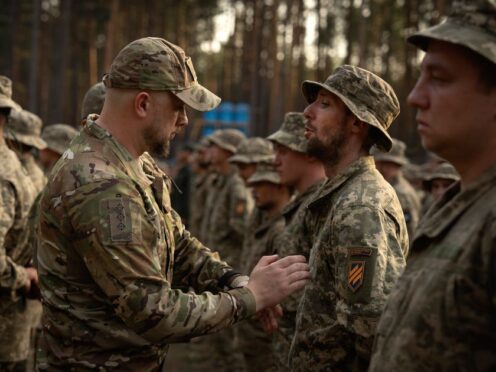
Ukraine has lowered the military conscription age from 27 to 25 in an effort to replenish its depleted ranks after more than two years of war following Russia’s full-scale invasion.
The new mobilisation law came into force a day after Ukraine President Volodymyr Zelensky signed it. Ukraine’s parliament passed it last year.
It was not immediately clear why Mr Zelensky took so long to sign the measure into law. He made only a brief public comment about it at a news conference in Kyiv on Wednesday with Finnish President Alexander Stubb.
An audit requested by Ukraine’s recently appointed commander in chief, Oleksandr Syrskyi, found that a previous estimate that the country needed 500,000 new recruits was wrong, Mr Zelensky said. That is partly because troops serving in the rear can be sent to the front line, he said.

Mr Zelensky said he was not ready to tell journalists how many new conscripts the Ukrainian army will need.
Conscription has been a sensitive matter in Ukraine for many months amid a growing shortage of infantry on top of a severe ammunition shortfall that has handed Russia the battlefield initiative.
Russia’s own problems with manpower and planning have so far prevented it from taking full advantage of its edge.
But the Russian military on Wednesday said it has experienced a recent surge in enlistments, attributing it to public outrage over last month’s terror attack on a Moscow concert hall that killed more than 140 people.
About 16,000 people have signed up in the last 10 days, Russia’s Defence Ministry said. Its claim could not be independently verified.
An affiliate of the so-called Islamic State group claimed responsibility for the attack. The Kremlin has insisted, without providing evidence, that Ukraine and the West played a role in the killings, despite their strong denials.

The law Mr Zelensky signed to lower the conscription age, known as 9281, is distinct from a more controversial and expansive draft mobilisation law which is still being considered in parliament.
That bill, known as 10449, would not only lower the conscription age, but also spell out who has the right to exemptions, among many other issues. This legislation, expected to be deeply unpopular, has proven harder to pass in parliament, with more than 1,000 amendments submitted by politicians.
Mr Zelensky also signed two other laws pertaining to mobilisation, including one that creates an online registry for recruits.
“These laws introduce changes only to some aspects of the mobilisation process. But still there are many other issues that have to be resolved,” said Oksana Zabolotna, an analyst with the Centre for United Actions, a government watchdog in Kyiv.
Lowering the conscription age probably would not meet the military’s earlier request for 500,000 new recruits, she said.
“There are about half a million men aged 25-27. Some of them are unfit for service, some have left, some are (in the) reserve or have the right to deferment,” she said. She estimated the new law may achieve about 10% of the goal.
That is still a step forward. The average age of Ukrainian soldiers, like those on the Russian side, is around 40, military analysts say.

Some Ukrainians worry that taking young adults out of the workforce will backfire by further harming the war-ravaged economy, but the problem reportedly has become acute as Kyiv prepares for an expected summer offensive by the Kremlin’s forces.
The initial enthusiasm for going out to fight against the Kremlin’s forces has waned, though public support for the war remains high.
Ukraine currently forbids men younger than 60 from travelling abroad. Commanders say they do not have enough soldiers to launch offensives, and barely enough to hold positions during intensifying Russian assaults.
Russia’s population is more than three times as large as Ukraine’s, and President Vladimir Putin has shown a willingness to force men to the front if not enough volunteer.
Mr Zelensky has rarely mentioned the mobilisation issue, and parliament has held long and inconclusive debates about it in recent months.
Last December, Mr Zelensky said Ukraine’s military wanted to mobilise up to 500,000 more troops. But he said he had asked the top brass to spell out the details on what is “a very sensitive matter” before deciding whether to grant their wish.
Such a major mobilisation would cost Ukraine the equivalent of 13.4 billion dollars, Mr Zelenskyy said at the time. Other aspects to be considered include whether troops currently on the front would be rotated or allowed home leave, he said.

The need for a broad mobilisation to beef up the number of Ukrainian troops reportedly was one of the areas of disagreement between Mr Zelensky and General Valerii Zaluzhnyi, the popular commander in chief of Ukraine’s armed forces whom the president replaced in February.
Ukrainian Defence Ministry statistics say the Ukrainian military had nearly 800,000 troops in October. That does not include National Guard or other units. In total, one million Ukrainians are in uniform.
Meanwhile, Ukraine’s air force said it shot down four drones that Russia launched overnight over central provinces.
An 11-year-old boy died in a hospital from injuries sustained during Russia’s attack in the Kupiansk area on Tuesday, according to Kharkiv regional governor Oleh Syniehubov. His 58-year-old father was killed in the attack.
Mr Zelensky said on Wednesday that Kharkiv, Ukraine’s second-largest city, “sees daily humiliation and pain” from unrelenting Russian aerial attacks.
Russian attacks all across the country are “wreaking havoc”, Mr Zelensky wrote on X, formerly Twitter, in an appeal for Ukraine’s western partners to supply more air defence systems.
In March alone, the Kremlin’s forces launched more than 400 missiles of various types, 600 Iranian-designed Shahed drones, and more than 3,000 guided aerial bombs against Ukraine, he said.

Enjoy the convenience of having The Sunday Post delivered as a digital ePaper straight to your smartphone, tablet or computer.
Subscribe for only £5.49 a month and enjoy all the benefits of the printed paper as a digital replica.
Subscribe